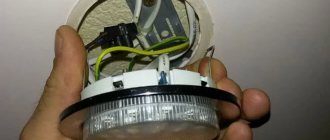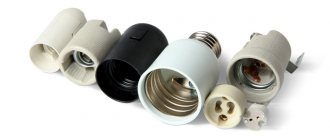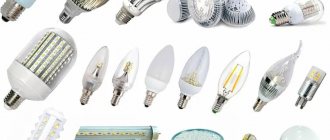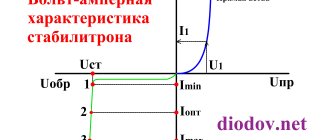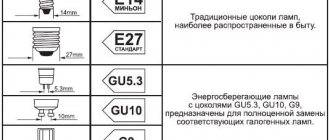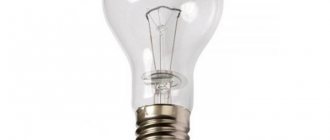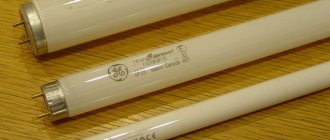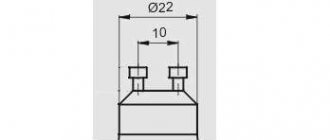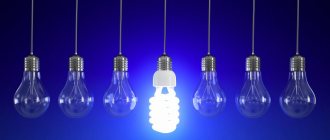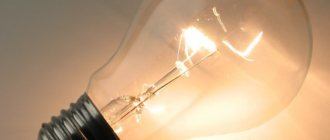A well-known lighting device - a light bulb - consists of two parts - a bulb and a base.
Using the base, the lamp is mounted in the socket and electric current is supplied through it. There are two types of lamp bases that we use in everyday life:
- threaded
- pin
Each is alphanumerically marked. The capital letter of the Latin alphabet indicates the type of base - E - threaded base, Edison base; G – pin base. The numbers that follow it indicate the diameter of the base in millimeters or the distance between the pins. More complex devices have more complex bases, and the markings are also different, but we will not write about them in detail in this article. Our task is to deal with household lamps. The most common threaded sockets in everyday life are E27 and E14.
Purpose of the lamp base
The lamp base has two purposes:
- Ensuring the operation of the device. The base and socket have contacts, as a result of the connection of which the light source is powered from the mains.
- Possibility of changing the lamp in case of failure or the need to replace it with a device with different parameters. The base-to-cartridge connection should ensure the safety and ease of this operation.
Some types of lighting fixtures do not have a base. They are connected to the electrical circuit using flexible wires.
As a rule, this option is used for low-power lamps that are subject to physical impact or shaking. The “cartridge-base” connection in this case will be a weak point, as a result of which the contact will break.
The W5W baseless lamp is designed for 12 V. It is produced for automotive lighting systems, where the device operates in conditions of shaking and increased vibration.
What it is
By socket we mean, in a sense, an adapter between the socket and the lighting fixture. It ensures reliable fixation of the flask with its contents in a specific connector that is connected to the power source.
Externally, the case may look like a sealed box in which the contacts are completely hidden. An example is Edison's invention. Most variations are represented by a block from which metal pins, plates, and wires are released, which are responsible for conducting energy from the cartridge to the diodes or filaments.
Inside the simplest base
Types of connectors for lighting devices
Many countries have long implemented standards regarding lighting devices. Now, in the period of globalization, you can buy devices from different manufacturers, including foreign ones. Therefore, the number of connection types is very large.
Type “E” – Edison base
The oldest type of connecting a light source to an electrical network is the standard and familiar light bulb base in the form of a screw connection. The number in the marking indicated immediately after the letter “E” indicates the thread diameter in millimeters. There are 10 standard sizes of the Edison base.
Lamps with micro-base “E5” are often installed in foreign household appliances, devices and control panels.
Twelve-volt LED DC lamp in “E5” format. With the same microbase, you can purchase devices designed for voltages of 6, 14 and 28 V
The miniature “E10” base is used for lighting refrigerators, ovens and similar equipment.
The Christmas tree garland bulbs are equipped with an “E10” connection. Most often you can find LED or neon light sources for this format.
Mini-chandelier sockets “E11” are often used in foreign equipment. For domestic devices, lighting sources with a different connection are used.
This twelve-volt incandescent lamp operates on 24 V DC. It is used in medical equipment
The “E12” format is used in interior lighting of household appliances and in imported chandeliers.
Such light bulbs operate on a standard 220 V network. They are rarely found on sale, so their price is quite high
The "E14" format is often called "minion". This is one of the standard socles in the territory of the former USSR.
Many chandeliers, floor lamps, and sconces are equipped with lamps with 14 mm thread sockets.
For the “E14” base you can purchase both ordinary cheap incandescent lamps and expensive energy-saving LED products produced by well-known companies
Lighting fixtures in the US and Canada have three screw connection formats. One of them is “E17”.
These original design lamps are made in the USA and are designed for 110-120 V. They will not be suitable for our networks without prior voltage modification
The second American format is “E26”. It is even more common than the previous one.
This LED light bulb operates on a voltage of 110-120 V. For the “E26” format, there are cheaper, but less economical analogues based on incandescent filament
“E27” – The most popular format in Russia. You can find light sources for this base in almost any store. Due to its prevalence, most lamps are produced to this standard.
The most common and familiar incandescent light bulbs with an “E27” base are designed for 40, 60, 75 or 100 watts
Another North American format, “E39,” is designed for powerful light sources.
In fact, E39 lamps can be screwed into the more common E40 socket. But we must remember that they operate on a voltage of 110-120 V
The last format in this list, “E40,” is standard for Russia. Powerful lighting fixtures are made for it, placed, for example, on lamp posts.
Typically, the “E40” format produces powerful incandescent lamps, as well as diode and gas-discharge lamps, which consume from 100 to 1000 W
Now the share of lamps with Edison base is decreasing. This is caused by the use of smaller and more economical light sources. However, in Russia the use of threaded connections is still the most popular.
Type "B" - bayonet base
Bayonet (bayonet, pin) connection occurs due to insertion and rotation. It is used in many industries, including electrical engineering. The main area of application is lighting devices that operate under vibration conditions.
This mainly concerns transport. The bayonet connector is standard on electrical systems in the UK and some other countries.
The bayonet type of connection is gradually replacing the classic threaded one. It is easier to make and use
Fasteners with this format are marked with the letter “B”, followed by a number indicating the diameter of the body in millimeters.
Depending on the number of contacts, another letter is added at the end:
- “s” (single) – one contact;
- “d” (double) – two contacts;
- “t” (three) – three contacts;
- “q” (quarto) – four contacts;
- “p” (penta) – five contacts.
A lamp format with three or more contacts is classified as specific industrial equipment. They are not used in everyday life.
A light source with a bayonet base and one contact looks like this. “B9s” 120 mA incandescent lamps cost about 30 rubles
The automobile version is marked with the letters “BA”. The main difference is the length of the pin. For an ordinary base this parameter is in the range [0.9; 1.1] mm, and for an automobile the minimum length starts at 0.64 mm.
The BA15d base has two exposed contacts. A threaded connection will not work here (as with all multi-contact joints), since the bulges may not coincide with the cartridge plates. That's why they use the bayonet system
In addition to the variety associated with the number of contacts, there is another feature that complicates the search for the right type of bayonet base for lighting lamps.
In a standard connection, both pins are located at the same level horizontally and the angle between them is 180°. But if after “B” or “BA” there is also a letter “U”, “X”, “Y” or “Z”, then this means that the pins are offset from their standard position.
GOST IEC 60061-1-2014 is an interstate standard that also establishes the parameters of socles. The diagram shows a list of “bayonet” formats
Therefore, when purchasing bayonet lamps (especially for cars), you need to be very careful about each letter of the code that describes the base.
Type "G" - two-pin connector
Another popular type of connecting a lamp to the network through a socket is a two-pin base. It is used in connections of LED and fluorescent lamps. Such a mount is marked with the letter “G” of the Latin alphabet. The numbers that come after it indicate the distance in millimeters between the pins.
Like the bayonet connection, there are modifications to the “G” format. They are designated by adding one of the letters "U", "X", "Y" or "Z" before the numbers. In this case, there will be some differences from the basic format, which can be expressed in the thickness and length of the pins, the presence of grooves and cutouts on the base.
For example, the “GU4” format has thicker pins than the “G4” type, and the “GZ4” type also has longer legs. Therefore, you need to carefully consider the description of the connector, since the modifications are not interchangeable.
“G4” pin sockets are the smallest of this format. They are usually equipped with halogen and LED lamps with a power of 3 to 20 W
Light sources with mounting types “G5.3”, “GU5.3”, “G6.35”, “GU6.35” and “G8” look and are used similarly.
Starting with the “G9.5” base, the wire-shaped pins are noticeably thicker.
Starting from the “G9.5” base, the conductive contacts are much thicker and more massive. They are difficult to bend, which is often a problem when installing smaller lamps
The “G9.5” format has three similar modifications with the letters “X”, “Y” and “Z”. In appearance they are almost identical.
The purpose of lamps in the “GX9.5”, “GY9.5” and “GZ9.5” formats is completely different. These are powerful lamps up to 1 kW, operating on alternating current.
Lighting devices with the “GU10” and “GZ10” connection format are produced mainly in China.
The pins of the “GU10” and “GZ10” socles have the original shape of the legs. Energy-saving lamps made in China are equipped with this connection.
There is no “G11” format, but there is a twin version “2G11”. Also, the sockets “2G7”, “2G23” and “2G27” have 4 contacts each.
Some lighting fixtures require a 4-pin connection. In the photo - fluorescent lamps with high luminous efficiency for the base “2G11”
The pins at the base “G12” and “G13” have the usual even shape. The 13th format uses tubular LED lamps.
The G12 base format is quite widespread. Both LED and ordinary lamps with incandescent filament are produced for it.
The next two-pin connector in order is “G23”. It has an original look, quite different from smaller devices.
Lamps with a “G23” connector are produced mainly for special needs. In the photo - a bactericidal lamp made in Italy
The “G24” socket is used for compact fluorescent lamps, the tube of which is folded in four.
There are three modifications of the “G24” base, which differ in grooves. If you use the wrong option, you will not be able to install the lamp in the socket.
There are very rare lamps for "G36" and "G38" sockets for use in narrow areas. Thus, the Sylvania FKK CP73/CP41 halogen type model with a “G38” base is used for photo optics.
LED and halogen lamps with a G53 base are powerful ceiling lighting devices. Instead of the usual pins, plates serve as a conductive element
The given list of two-pin connection formats shows how diverse there are bases for light bulbs of seemingly the same type. Therefore, if the markings of the cartridge are not known, then you need to carefully measure its parameters or bring it to the store.
Type “F” – single-pin connector
On some types of tubular halogen and fluorescent lamps, single-pin sockets are sometimes used, which are located at both ends of the lighting device. This solution allows you to simultaneously pass electric current and securely fix the lamp. This type of mount is marked with the letter “F”.
There are 3 modifications depending on the shape of the pin:
- “a” – cylindrical;
- “b” – corrugated;
- “c” – special.
The number that closes the code name of the base indicates the diameter of the pin in millimeters.
The “Fa4” type socket has been used for halogen lamps since the times of the USSR. Finding lighting devices and cartridges for this format is easy.
The “Fa4” format mount is provided by bright halogen linear lamps with a power of 2 kW and a luminous flux of about 50 kLm. They are used in outdoor lighting systems, for shops and exhibition halls
The “Fa6” type connector is used by foreign manufacturers to equip fluorescent lamps. They are used where, according to fire regulations, the occurrence of an open fire is unacceptable.
This can be not only large-scale, but also small-scale production. Wood or flour suspension can cause an explosion, so such a lighting source is relevant for a carpentry or flour mill.
Specific fluorescent explosion-proof lamps produced by the French company Philips. Using the “Fa6” connector avoids arcing on the electrical contact
For household purposes, you can also use lamps with the “Fc2” format.
A metal halide lamp with an Fc2 base can be used to illuminate large open areas, such as the local area of a cottage.
Bases with grooved pins are now out of use.
Type “R” – with recessed contact
This type is very similar to the "F" format, however the lamp contacts are recessed inside the pin. The socket for such a base contains two spring-loaded metal protrusions that fix the lamp and provide electrical commutation.
There are only two types of such sockets: “R7s” and “Rx7s”. The pin diameter for both options is 7 mm. The main difference is in the mounting geometry.
Both high-power halogen and metal halide lamps, as well as ordinary LED and gas-discharge lamps, are produced for “R” type sockets
There is also a modification “Rx7s-24”. The difference from the “Rx7s” is only in the length of the lamp - 132 mm versus 120 mm. Those. the base part is identical, but the length of the cartridge for the Rx72-24 will be longer.
Type “S” – soffit base
The soffit type got its name because of the typical area of application of the lamps - lighting of bathrooms and stages, illumination of mirrors. It can be located on both sides for tubular type lamps or as a single base.
This type of fastening is designated by the letter “S”. The number following it shows the diameter of the base housing.
Lamps with double-sided soffit sockets “S6”, “S7” or “S8.5” are produced for the automotive industry. They are used to illuminate license plates and instruments in the cabin.
For tubular lamps, the “S14” connector format is often used, for which there are two varieties. Models “S14s” have two contacts on the sides, and “S14d” have one paired one in the middle. The shape of the plinth body differs from the usual one.
In terms of their main characteristics, these lamps do not differ from each other. Attaching to the cartridge also does not cause problems, so there is no justified advantage of one type over another
The “S19s” base shape is classic for soffit connectors.
Incandescent lamps with the “S19s” mounting type are used in audio equipment, frequency translators and other radio and electrical equipment. They can be purchased at stores specializing in the sale of spare parts for electronics.
Lamps with a soffit base housing diameter exceeding 19 mm are not produced.
Type “K” – with wired connection
Instead of the standard socket-socket combination, a cable connection is sometimes used, which is called a "wired socket". It is marked with the letter “K”.
The cost of high-pressure gas-discharge lamps is at least 10 thousand rubles. They require high power (usually 1-2 kW) and emit light with a brightness of up to 250 kLm
Such lamps are used to illuminate large objects. Since the conditions for installing floodlights are different everywhere, the best option for connecting such devices is to use a wire base.
Type “H” – for xenon lamps
There are many different light sources installed in a car. For precise placement of light bulbs, special sockets marked “H” are used. This is necessary primarily for focusing the headlights. The number following the letter indicates the subtype of this format.
Table of types of lamps used in cars. Nowadays, all specialized stores have electronic catalogs that can be used to check the range of light sources
The conductive plates are designed in such a way as to fix the light bulb in a certain position, taking into account the vibrations and shaking that occur when the car moves.
Type "P" - flanged bases
The flange type of base is used when it is necessary to clearly focus the light source, which is why it is often called “focusing”. Lamps with this type of mounting are used mainly in the automotive industry.
The diversity of car manufacturers has led to a significant number of formats, standards and specifications. This was also reflected in light sources installed in cars.
It should be noted that the shapes of “P” type socles are varied and do not have any common geometric features.
Their separation into a separate type occurs only because of the ability to clearly establish the light source relative to the reflector or lenses.
Type “T” – telephone format
The telephone socket is used for small light bulbs that are installed in switchboards, control panels and cars. Light sources with this connection format are designated by the letter “T”, followed by a number indicating the mounting diameter in millimeters.
The smallest T-mounts differ only in diameter. On the left is a lamp with a “T3” base, in the center and on the right – with a “T4.7” base
The "T6.5" format has a similar appearance. But lamps with a “T5” socket, which are used in a car’s dashboard, look different.
One of the most common types of telephone mounts is “T5”. The base housing is made of plastic, so it is cheap
Two more formats that are often used for vehicles: “T10” and “T20”.
The “T10” and “T20” type sockets are identical and differ only in size. Such lamps are used to operate parking lights, brake lights, reverse lights, etc.
Since LED bulbs heat up, the bases are made of heat-resistant plastic. It must withstand temperatures above 130°C.
Characteristics
The dimensions of the bases are not always directly proportional to the required output luminous flux power. For example, E40 has a coil diameter of 40 mm, and R7 only 7 mm. And the output power of the former reaches 1000 W, while the latter can shine at 1500 W.
The markings of the bases of all light bulbs are presented in uppercase, lowercase letters and numbers. By number we mean geometric characteristics. The Latin alphabet means the following:
| B | Pin (bayonet) | s | 1 contact |
| E | Threaded (Edison) | d | 2 contacts |
| G | Pin | t | 3 contacts |
| K | Cable | q | 4 contacts |
| P | Focusing | p | 5 contacts |
| R | With recessed contacts | ||
| S | Soffitny | ||
| T | Telephone | ||
| W | Baseless lamps |
Marking
If the number appears immediately after the capital letter, then it indicates the outer diameter of the base (E27) or the distance between the central points of the protruding contact elements (G4). Additionally, A (car lamp), U (energy saving) or V (conical shape of the lower part of the base) may be indicated.
Using Base Adapters
Sometimes situations arise when it is not possible to find a lamp with the required parameters for a specific format. For example, after purchasing a three-arm chandelier with “E14” sockets, installing it and connecting the lamps, it turns out that there is not enough light from it, even when using powerful LED sources such as Lightstar T35, which produce 950 lm.
In order not to change the chandelier, you can use special adapters from one standard size “E” base to another. By using the “E14 –> E27” adapter, you can connect “E27” format lamps, which can produce a more significant luminous flux. For example, the X-flash 50 model shines with a brightness of 1650 lm.
Also on sale are adapters from one type of base to another. The most popular types are “E –> G” and vice versa. All these devices can be purchased in stores or ordered on well-known online platforms.
Design
With the exception of W, all lamp bases have a housing. It can be made of aluminum, glass or some kind of plastic. If it is metal, then an additional layer of insulating material is applied to the cylinder.
At the bottom of the base there is either 1 contact or a whole group of several antennae, pins or plates. There is an insulator between them. On the inside, they are connected to filaments or diodes through thin copper wires.
Fluorescent Lamp
In all lamps, a vacuum is created under the glass. That is, the air is pumped out. A rod is provided for this purpose. Halogen vapors are also released into the flask through a glass tube.
Different lamps have their own nuances regarding additional elements. For example, the R7 has a spring mechanism, and a car headlight has a light bulb whose base is equipped with an adjusting ring.
Conclusions and useful video on the topic
Types of lamps for conventional screw sockets:
You must buy a lamp in strict accordance with the socket markings. In simple cases, especially for the “E” format, you can do this yourself. But for other types there are many modifications and nuances. If in doubt, it is better to contact a consultant in a specialized department.
If, while reading the article, you have questions or have information that complements the information presented, please write comments in the block located below the text.
Foreign marking
The types of cap designations discussed above are accepted in most countries of the world, but there are several differences.
For example, when searching for bayonet lamps in Russia, it is better to indicate the capital letter Ш; in the USA, bayonet sockets are marked with a capital Latin letter B, which, if there are small fasteners, are supplemented with a lowercase letter a. Also, threaded lamps in the USA are marked with the capital Latin letter M.
- Related Posts
- Design and features of a CFL lamp
- What is a driver and why do LEDs need it?
- Reasons for blinking tape
How to connect the cartridge correctly?
Among household products, the most difficult to connect wires to is the old type of cartridge - “Soviet”, since it must first be disassembled.
These devices are easily recognized by their black polymer housing. To get to the terminals, the carbolite housing must be unscrewed.
Disassembly is carried out by rotating the body parts in opposite directions. As a result, the cartridge is divided into 3 parts: the holder (the largest element), the rear part and the central part - the contact ceramic insert
To secure the wires, they need to be stripped and shaped into “loops” to make it easier to secure to the contacts. The phase is fixed to the central screw contact, zero - to the second terminal.
When tightening a threaded connection, it is necessary to apply force and remember that it simultaneously transmits tension to the contact. When the wires are connected, all that remains is to connect the two parts of the housing.
Mounting methods in lighting fixtures
Difficulties in installing the socket may be caused by the design of the chandelier or lamp. In order to quickly cope with the replacement of a broken product, we recommend that you become familiar with its structure and position in advance, before the initial installation of the lighting device.
Lamp manufacturers most often choose the following methods of mounting sockets:
- for the electrical wire;
- on a metal tube;
- using a bushing;
- latches.
Option number 1 . When attaching to an electric drive, it is necessary to additionally strengthen the wire; for this, use a sleeve with a fastening screw, which is screwed into the bottom of the cartridge.
Option number 2 . The metal tube is used more often, as it allows the installation of heavy chandeliers with a large number of decorative elements.
Often, instead of a tube, a metal chain is used, which also reduces the load on the electrical wire and allows you to adjust the height of the lighting fixture.
Option number 3 . Cartridges with bushings are heated, as a result of which the elements are deformed. Therefore, it is recommended to replace plastic bushings with metal ones.
Option number 4 . The latter mounting method is suitable for devices with screwless terminals. The cartridge is installed in parts. First, the bottom is secured, then the wires are inserted, and only then the remaining part of the cartridge is mounted using latches.
Connection option with screw terminals
Cartridges of a more modern type do not need to be disassembled - the terminals are located on the outside. The wires are fixed with screw clamps, the connection process takes only a few minutes.
The only disadvantage of such a cartridge is the impossibility of repair. If the terminals are burnt or the product is deformed, you will have to replace it completely.
Image gallery
Photo from
Step 1 – stripping the ends of the wires
Step 2 - unscrewing the mounting bolts
Step 3 - phase determination and terminal selection
Step 4 - Connecting Wires to Terminals
The connection option with clamps is relevant for luminaires designed for E14 and E27 lamps. When installing a new cartridge and replacing it, be sure to check it for integrity and compliance with standards.
Let's assume that the number of turns must be at least three, and there must be no cracks or chips on the body.
Incandescent lamps
The incandescent lamp (LOL) appeared in the mid-19th century, becoming the first source of electric light. Since then, its design has remained virtually unchanged: the lamp consists of a vacuum glass cylinder, a base with contacts and a fuse, and a light-emitting filament.
The incandescent coil is made from tungsten-based alloys that can withstand a combustion temperature of +3200 degrees. The thread does not burn out instantly, since the cylinder is filled with inert gas.
The operating principle of the LON is simple: a conductor of small cross-section and low conductivity passes current, part of the energy is used to heat up the conducting spiral, due to which it begins to glow.
There are several types of incandescent light bulbs:
- Decorative - shaped like a candle, used in sconces.
- Painted - used for decorative purposes.
- Mirrored - direct light downwards, used in ceiling lamps.
- Local lighting – used for emergency lighting, flashlights.
The advantages of incandescent lamps are low cost and ease of installation. The main disadvantages are short service life (500-1000 hours) and low efficiency, amounting to up to 3% of energy consumption. In addition, LONs are unsafe: if you put a newspaper on a light bulb, it will light up after 20 minutes. Therefore, incandescent lamps cannot be used in small lampshades made of plastic and wood.
Halogen lamps
Halogen light bulbs work on the same principle as incandescent light bulbs. The only difference is in the gas. The cylinder of a halogen lamp is filled with an inert gas mixed with iodine or bromine, due to which the filament can operate at a higher temperature, and tungsten evaporates less.
Thanks to improved technical parameters, it has become possible to reduce the size and increase the service life of halogen light bulbs by 2-3 times compared to conventional ones. Since the glass began to heat up to too high a temperature, it was replaced with quartz material. Halogen lamps are damaged by dust and quickly burn out if you touch the cylinder with your bare hand.
Halogen bulbs have a mirror coating applied to them, which reflects the light, directing it straight down in a compact beam. Therefore, the scope of their use is portable and stationary spotlights, as well as plasterboard structures.
The main disadvantage of halogen lamps is their instability to voltage surges. This requires the use of a transformer that equalizes the current.
How and which driver to choose for g4 12v LED lamps
Navigator power supply
A driver, also known as a power supply/power supply/step-down transformer, is required to convert 220 V household voltage to 12 V.
There are two types of drivers:
- delivering direct current (suitable for LED operation);
- producing constant voltage (suitable for LED strips and low-voltage light bulbs).
You can read more about drivers in the article “What is a driver and why do LEDs need it?”
For 12 V LED lamps you need a second type: a constant voltage unit.
To select a driver, you need to know two parameters: the total output power of the light sources in the chandelier (just add up all the powers and multiply by a safety factor of 1.2) and the output voltage of the power source. In our case, this is 12 V. Knowing these two parameters, you can select a power supply.
As additional selection parameters, it is recommended to pay attention to the protection class of the power supply. The higher the IP, the better.
Most often, LED manufacturers also produce drivers. It is best to choose a device from a well-known and reliable manufacturer.
- Related Posts
- Light sources and what they are
- LED warehouse lighting: selection, calculation and installation
- How to properly use emergency lighting with all current standards and requirements
Application table
Determining which lamp is used where is not always easy. A table listing standard sizes and areas of application will help with this.
| Marking | Application |
| E14, E27 | Household lighting fixtures: floor lamps, chandeliers, sconces |
| E40 | Powerful lighting of large rooms, street lighting |
| G4, GU5.3, G9, G10 | Decorative lighting, spot lighting, interior lighting |
| G13 | Tubular oblong lamps |
| 2G11 | Table lamps for lighting and disinfection |
| GX53, GX70 | Recessed, surface-mounted lamps |
| GX24q-4 | Downlights, table lamps, interior lighting devices |
| R7s | Spotlights, floor lamps, floor lamps, downlights |
| B | Double spiral car lamps |
| S | Illumination of furniture, instrument panels, license plates |
| P | Flashlights, projectors |
| T | Illumination of automation panels, control panels |
| W | New Year's garlands, car turning mechanisms |
The base size marking is on the lamp packaging, in the instructions, and on the bulb. Also, information about a suitable light source is indicated in the instructions for each technique.
All the necessary characteristics are on the packaging.
